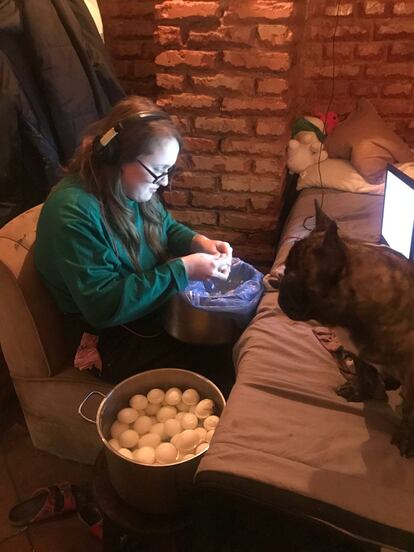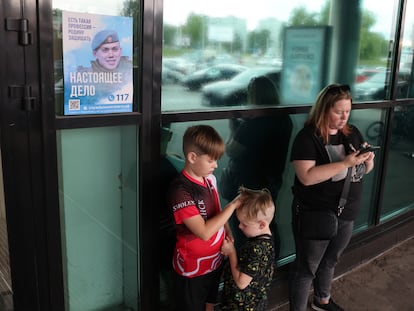Destroyed schools and bomb shelters: The Ukrainian teachers the war cannot silence
With schools demolished by shelling and students evacuated, educators continue to give classes from basements or air raid shelters to provide a small sense of normalcy

At Valeriia Hukova’s school in Kharkiv, time stood still on February 23, 2022, the last date written in chalk on the 24-year-old teacher’s blackboard. The next day, at 5 a.m., Hukova awoke to the sound of war coming through her window. Although at the time she did not yet realize it, the Russian invasion of Ukraine had begun. Hers is the testimony of a primary school educator who would spend 42 days teaching her students online from the small corner of a bomb shelter. Like her, many other teachers performed then, as they do now, acts of impossible dimensions to maintain the timetable and give their students a small sense of normalcy.
“That morning, Sasha [her boyfriend] and I took our things and our pets and went to the cafe where he worked as a cook, in the basement of a residential building dating back to the World War II era,” Hukova recalls. For several weeks, around 30 people lived there, amid fear and uncertainty. On March 1, she spoke for the first time to her students, who only wanted to know where she was and how she was. They eventually resumed classes. A few days later, on March 11, Hukova went back to work, while Sasha and other volunteers prepared enough food in the local kitchen for hundreds of people sheltering in the subway tunnels.
“Whoever could work, worked; whoever could help in the kitchen, worked,” she explains in front of the webcam where she tells her story. “It was extremely difficult, because there were about 30 people and I was asking them all the time to lower their voices [...] I would even go to the kitchen and ask the men, who were cooking all that food, to make less noise because I was working with my children,” she says with the smile of one who even now feels embarrassed by those requests. First, she taught third grade children; then she began to teach fourth grade, and later even teenagers. This lasted for 42 days until artillery fire destroyed the wiring and the internet connection disappeared. She then decided to move to Poltava, a town west of Kharkiv, to continue teaching her students from a hostel room. And as such, she was able to finish the course.

A digital archive for victims of war
Hukova’s testimony, like that of many others, was collected on video thanks to the Museum of Civilian Voices, a digital archive created by the Rinat Akhmetov Foundation with the purpose of safeguarding the memory of what is happening and the impact the war has on the non-combatant population. “We did it without any specific goal, beyond storing those testimonies and offering them psychological support from a distance, as therapy,” Natalia Yemcheko, the museum’s spokesperson, says via videoconference. This work actually began in 2014, when the war in Donbas against Russia-backed separatists broke out. “The only way to overcome any trauma, and PTSD in particular, is to name and recognize the problem, to be able to talk about it and thus understand what is happening to yourself. Collecting these testimonies about their war experience is a therapeutic process, if done in the right way,” she adds.
The testimonies include those of Olena Peslyak, the principal of a school in Opytne destroyed by the Russian army; Liubov Shamota, whose school in Yasnohorodka was transformed into a center for first aid and humanitarian assistance; Mykhailo Vereskun, a professor at Pryazovskyi State Technical University, who lost many of his friends and colleagues in the shelling of Mariupol; and many others, including people included in this report.
Since then, more than 86,000 stories have been collected in the digital archive, with a protocol that includes four steps: preliminary conversations to determine if the person is ready to share their story and if it will help them process their trauma; obtaining authorization to handle their data and share their testimony; the interview itself; and publication, if appropriate (only 10% of the material has been made public). A process that, Yemcheko explains, does not affect everyone equally: “In my opinion, even children who have not looked the war in the face, but who have been forced to leave their homes and even their country, or who have lost someone close to them, are traumatized. And their testimonies should be collected, if they are psychologically prepared and their parents or legal guardians agree, because they are an important part of the conflict and war crimes.”
The foundation also organizes camps for children who have suffered trauma, where the psychological component is very important. There, they learn to preserve their memories and to make a video diary as a tool for self-reflection, to understand what they are going through, and to be able to express it.

Destroyed schools and air-raid shelters
March 2 will remain forever etched in the memory of Larisa Bykova, headmistress of School 29 in Mariupol, in Donetsk province, under the control of Russian and separatist troops. Classes had been interrupted since February 24, and even teaching online was impossible, given the instability of the internet. However, about 20 people were living in the basement of the school; the families of teachers and students, whose buildings offered no shelter against air raids. It was a sunny day and the kids were lingering in the hallways, in the gym... even outside. It was lunchtime. “My husband looked out the window and was surprised to see three boys on the school soccer field. And then we heard a loud bang, and my husband yelled at us to get down on the ground,” Bykova recalls.
Immediately, that roar gave way to a thud, and suddenly all the windows exploded. “That’s when we realized it was a cluster bomb, because everything was destroyed by shrapnel. It seemed to come from everywhere. When we finally got down on our knees, the light was gone, and everything was white from the dust and plaster on the walls,” she recalls. With no time to panic, they ran to the basement, where they did a head count and realized the three students they had seen outside were not there. Outside, on the soccer field, was a crater where the three boys, aged 14 and 15, had once stood. One of them, Ilya, died instantly. Another lost his legs, and the third, who managed to save them, now lives in England, where he is being rehabilitated.
In those first months, the priority was simply to stay alive, Bykova explains by email. Those students were not the school’s only victim; they also lost two teachers, a psychologist, and several parents. Then began the arduous task of tracing the students, some of whom were abroad. “Above all, we didn’t want any 9th or 11th graders, who were going to graduate, to lose the year, so we started recommending everyone urgently enroll in distance schools in the unoccupied part of Ukraine.” On September 1 they resumed classes in virtual format, accepting all young people (aged 6 to 17) from Mariupol who wanted to continue their distance education in a Ukrainian school; and they started this year’s course in the same way.
The story of School 29, one of many, proves the extent to which having a bomb shelter has become a prerequisite for face-to-face education. From the beginning of the conflict up to August of this year, UNICEF has built 28 such shelters, with support from the European Union. In one of them, at a nursery school in Slavutych, in the north of the country, children spend naptime on cribs and beds in a space that they could not have renovated on their own. “The shelters are safe and child-friendly, which gives them a sense of comfort. A cheerful mural with a smiling cartoon ant welcomes the students, and teachers tell the children that they are ‘going to see the ant’ as they head underground,” UNICEF sources explain.
Anton Bilay’s story: “I had no choice”
At the Mariupol Polytechnic School, the start of the war saw almost all its students sent back home; even the majority of the 20 boarding students that the center had. Only three orphans who had nowhere else to turn remained. Anton Bilay, 42, and his wife cooked for them every day, along with 24 displaced people who were staying in a hotel a mile or so from the school, risking their lives under enemy fire until the situation became unsustainable: the school offered no protective shelter and Bilay asked the police for help. The boys were taken to a shelter at the Technical University.
They were only there for two weeks, until Ukrainian soldiers recommended they flee under the threat of new, more intense shelling. They were put on a bus and sent to a Russian checkpoint, and from there the three boys ended up at Pediatric Hospital Number 5, in the occupied zone. “During all that time, they were in contact with me on Telegram and Viber, thanks to some SIM cards that I had given them. In one of those conversations, Ivan, one of the boys, started crying and said to me: ‘Anton Viktorovych, please, get us out of here.’ So I had no choice,” explains Bilay in his testimony to the Museum of Civilian Voices. Few would have done what he did: from Mariupol to Poland, Lithuania and Latvia, he traveled thousands of miles in three days to rescue his students. He had to cross the Russian border on foot and finally reached the hospital, where he picked up two of the boys; the third had been taken in by a family. And from there, back to Kyiv, where they hope for a happy ending, if possible, to a war that has already displaced more than 13 million people and caused the death of almost 8,900 civilians.
Sign up for our weekly newsletter to get more English-language news coverage from EL PAÍS USA Edition
Tu suscripción se está usando en otro dispositivo
¿Quieres añadir otro usuario a tu suscripción?
Si continúas leyendo en este dispositivo, no se podrá leer en el otro.
FlechaTu suscripción se está usando en otro dispositivo y solo puedes acceder a EL PAÍS desde un dispositivo a la vez.
Si quieres compartir tu cuenta, cambia tu suscripción a la modalidad Premium, así podrás añadir otro usuario. Cada uno accederá con su propia cuenta de email, lo que os permitirá personalizar vuestra experiencia en EL PAÍS.
¿Tienes una suscripción de empresa? Accede aquí para contratar más cuentas.
En el caso de no saber quién está usando tu cuenta, te recomendamos cambiar tu contraseña aquí.
Si decides continuar compartiendo tu cuenta, este mensaje se mostrará en tu dispositivo y en el de la otra persona que está usando tu cuenta de forma indefinida, afectando a tu experiencia de lectura. Puedes consultar aquí los términos y condiciones de la suscripción digital.
More information
Archived In
Últimas noticias
Most viewed
- Reinhard Genzel, Nobel laureate in physics: ‘One-minute videos will never give you the truth’
- Oona Chaplin: ‘I told James Cameron that I was living in a treehouse and starting a permaculture project with a friend’
- Pablo Escobar’s hippos: A serious environmental problem, 40 years on
- Charles Dubouloz, mountaineering star, retires at 36 with a farewell tour inspired by Walter Bonatti
- Why we lost the habit of sleeping in two segments and how that changed our sense of time










































